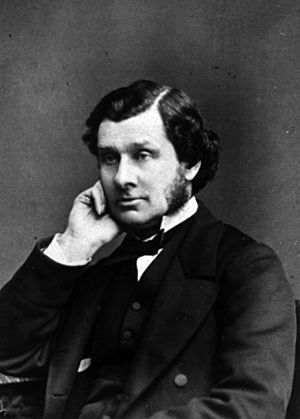Lionel Smith Beale facts for kids
Quick facts for kids
Lionel Smith Beale
|
|
|---|---|
 |
|
| Born | 5 February 1828 |
| Died | 28 March 1906 (aged 78) |
| Nationality | British |
| Occupation | Physician |
| Known for | Microscopy |
Lionel Smith Beale (born February 5, 1828 – died March 28, 1906) was a British doctor and scientist. He was a professor at King's College London. He was also famous for his work with microscopes.
Contents
A Life of Science and Discovery
Lionel Smith Beale was born in London on February 5, 1828. His father was also a medical professional. Lionel went to King's College School and then King's College London. There, he earned his degree in medicine. He also studied animals at the college.
After finishing his studies, Beale set up his own lab. He used his own money to do this. In his lab, he did research and taught others. He focused on chemistry and using microscopes.
In 1853, when he was only 25, King's College gave him an important job. He became a professor of how the body works (physiology). He also taught about how diseases change the body.
Sharing Knowledge with Archives of Medicine
In 1857, Beale started a science journal called Archives of Medicine. He was the first editor of this journal. He promised readers that the journal would have many pictures. He believed that "drawings are really of much more use than long descriptions." This showed how much he valued visual learning.
Beale worked as a doctor at King's College Hospital for 40 years. He later became a professor of diseases (pathology). Then he taught about the main ideas and practices of medicine. He retired from this role in 1896.
He received many honors for his work. These included the Baly medal in 1871. He was also president of the Quekett Microscopical Club and the Royal Microscopical Society.
Pioneering Medical Work
Lionel Smith Beale was a strong supporter of the scientific method in medicine. He believed in using careful observation and experiments. He taught and spoke about this idea often.
He strongly believed that microscopes were very important. He felt they were key to understanding diseases. Microscopes helped him see tiny details of sick tissues.
Understanding Cells and Cancer
In 1854, Beale wrote a book called The Microscope in its Applications to Practical Medicine. In this book, he described cells. He said a cell was like a closed bag. Inside, it had a nucleus. The nucleus usually had a bright spot called a nucleolus.
He sorted cells by their shape. He also sorted them by where they came from in the body. He discussed how to tell cancer cells apart. He looked for differences from normal cells that looked similar. In 1860, he even found cancer cells in sputum (mucus coughed up from the lungs).
The Mystery of Life: Bioplasm and Vital Force
Beale was a pioneer in a technique called differential staining. This means using different colors to stain parts of cells. He noticed that living things reacted differently to stains than non-living things. From this, he thought the nucleus held something special. He called this "bioplasm," or the essence of life.
He strongly believed there was a big difference between living and non-living matter. He felt that life had a special "vital force." This force was not just about normal physics or chemistry. He thought this force controlled matter and its energies. He believed it arranged things in ways that science couldn't fully explain.
Beale said that life has a "mystery." He felt this mystery became bigger the more one studied life. He believed that changes in living matter happen in ways that scientists cannot understand. He thought these changes were totally different from anything else known to us.

